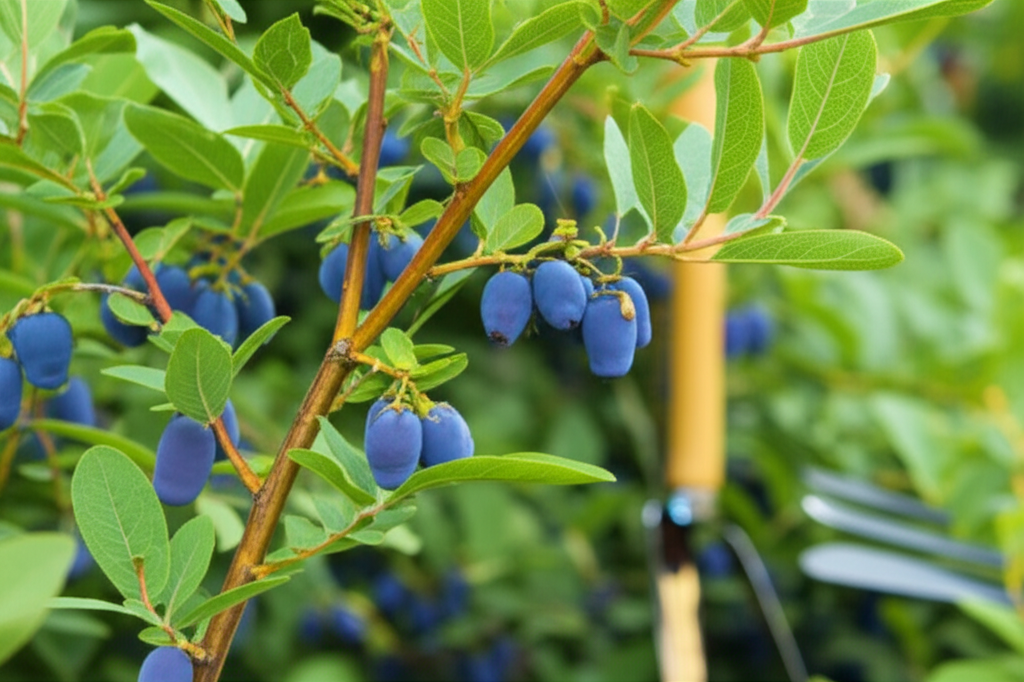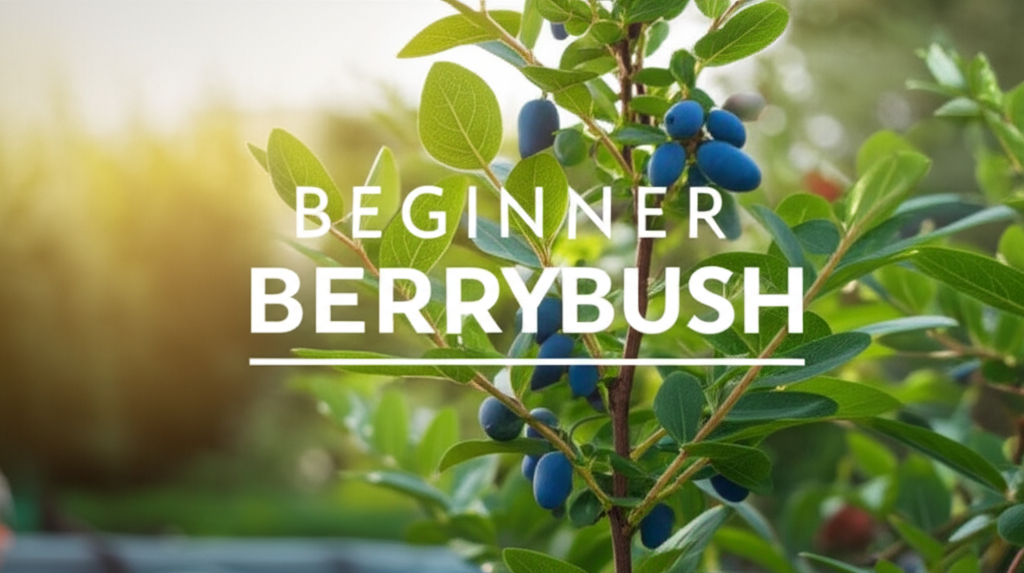Introduction to the Honeyberry Shrub
Are you looking for a fruit-bearing shrub that’s as rewarding as it is low-maintenance? Look no further than the honeyberry (Lonicera caerulea), also known as haskap. This hardy North American native is rapidly gaining popularity among home gardeners, and for good reason. It offers delicious, nutrient-rich berries, thrives in a variety of climates, and is remarkably forgiving for beginners. Forget the fussy requirements of some other berry bushes; the honeyberry is a true champion of the easy-care garden. In this guide, we’ll delve into everything you need to know to successfully grow honeyberries, from choosing the right varieties to harvesting your first bountiful crop.
What is a Honeyberry?

The honeyberry is a deciduous shrub belonging to the honeysuckle family. While many associate honeysuckle with ornamental vines, the Lonicera caerulea species is cultivated for its edible fruit. Native to the northern hemisphere, including parts of North America, Russia, and Japan, these resilient plants have adapted to survive harsh winters and produce fruit even in challenging conditions. The berries themselves are oblong, typically blue, and have a unique sweet-tart flavor often compared to blueberries with a hint of raspberry or plum. They are packed with antioxidants and vitamins, making them a superfood for your garden.
Key Characteristics of Honeyberry Shrubs
- Hardiness: Honeyberries are incredibly cold-hardy, often tolerating temperatures well below freezing. This makes them an excellent choice for gardeners in colder climates.
- Adaptability: They can grow in a range of soil types, though they prefer well-drained, slightly acidic soil. They are also tolerant of various sunlight conditions, though they fruit best with ample sun.
- Growth Habit: Typically, honeyberry shrubs grow to be 4-6 feet tall and wide, forming an upright to spreading habit. They are generally manageable in size for most backyard gardens.
- Fruit: The berries ripen early in the season, often before strawberries. They are a vibrant blue and have a distinct sweet-tart taste.
- Pollination: Most honeyberry varieties require cross-pollination to produce fruit. This means you’ll need to plant at least two different varieties that bloom at the same time.
Why Choose Honeyberry for Beginner Gardeners?
The honeyberry’s appeal to novice gardeners is multifaceted. Its inherent toughness and adaptability mean that minor mistakes are often forgiven, and the plant will still thrive.
Reasons for Honeyberry’s Beginner-Friendliness:
- Low Pest and Disease Susceptibility: Unlike many other fruit-bearing plants, honeyberries are not typically bothered by common garden pests like aphids, slugs, or deer. They are also remarkably disease-resistant, reducing the need for chemical treatments.
- Minimal Pruning Requirements: While pruning can improve fruit production, honeyberries are quite forgiving if left largely to their own devices. Basic pruning to remove dead or crossing branches is usually sufficient.
- Early Fruiting: You don’t have to wait years to enjoy the fruits of your labor. Honeyberry plants can start producing a decent crop within 2-3 years of planting.
- Drought Tolerance: Once established, honeyberry shrubs show good drought tolerance, making them less demanding in terms of watering compared to some other berry crops.
- Versatile Edible Use: The berries can be eaten fresh, used in jams, jellies, pies, smoothies, or even wine. Their unique flavor profile adds a delightful twist to culinary creations.
Planting Your Honeyberry Shrub
Getting your honeyberry off to a good start is crucial for a successful harvest. Follow these steps for optimal planting.
Site Selection and Preparation
Choosing the right location is the first step. Honeyberries prefer a spot that receives at least six hours of direct sunlight per day. While they can tolerate partial shade, fruit production will be reduced.
- Soil: Aim for well-drained soil with a slightly acidic to neutral pH (5.5-7.0). If your soil is heavy clay, amend it with compost or organic matter to improve drainage. Raised beds can also be a good option for poorly draining soils.
- Spacing: Give your honeyberry shrubs enough room to grow. Plant them at least 4-5 feet apart to allow for adequate air circulation and growth.
Choosing the Right Varieties
As mentioned, cross-pollination is essential for fruit production. You’ll need to select at least two compatible varieties. When choosing, consider their ripening times and disease resistance.
| Variety Name | Origin | Ripening Time | Berry Size & Flavor | Hardiness Zone |
|---|---|---|---|---|
| ‘Borealis’ | Canada | Early Season | Medium, sweet-tart, blueberry-like | 3-7 |
| ‘Tundra’ | Canada | Early Season | Medium, firm, sweet with a slight tang | 3-7 |
| ‘Honey Bee’ | Canada | Mid-Season | Large, juicy, sweet-tart | 3-8 |
| ‘Indigo Gem’ | Canada | Mid-Season | Medium, sweet, less tart than others | 3-8 |
| ‘Maxine’ | Russia | Mid-Season | Large, juicy, slightly tart | 3-7 |
It’s often recommended to purchase plants labeled as “pollinator” or “companion” plants for specific varieties. Check with your nursery or breeder for compatible pairings.
Planting Steps
- Dig the Hole: Dig a hole that is twice as wide and as deep as the root ball of your honeyberry plant.
- Prepare the Plant: Gently remove the plant from its container. If the roots are tightly bound (root-bound), gently loosen them with your fingers.
- Place the Plant: Set the plant in the hole so that the top of the root ball is level with the surrounding soil.
- Backfill the Hole: Fill the hole with the excavated soil, gently tamping it down to remove air pockets.
- Water Thoroughly: Water the plant deeply to settle the soil and provide essential moisture.
- Mulch: Apply a layer of organic mulch, such as wood chips or straw, around the base of the plant, keeping it a few inches away from the stem. This helps retain moisture, suppress weeds, and regulate soil temperature.
Caring for Your Honeyberry Shrub
Once planted, honeyberry shrubs are remarkably low-maintenance, but a little attention can go a long way.
Watering Needs
Newly planted honeyberries need consistent moisture to establish their root systems. Water them regularly during the first growing season, especially during dry spells. Once established, honeyberries are quite drought-tolerant and will generally only need watering during prolonged periods of dryness. Aim for about an inch of water per week, either from rain or irrigation.
Fertilizing
Honeyberries are not heavy feeders. In the first year, focus on watering and mulching. In subsequent years, you can apply a balanced, slow-release fertilizer in early spring, before new growth begins. An organic option like compost or aged manure is also excellent. Avoid over-fertilizing, which can lead to excessive leafy growth at the expense of fruit production.
Pruning for Success
While honeyberries are tolerant of neglect, strategic pruning can enhance fruit yield and plant health.
- Establishment Pruning (First 2-3 Years): Focus on shaping the plant. Remove any weak, damaged, or crossing branches. Aim for a strong central leader and a well-spaced structure.
- Annual Pruning (After Fruiting): The best time to prune is after the berries have been harvested, typically in late spring or early summer.
Remove any dead, diseased, or damaged branches.
Thin out crossing or inward-growing branches to improve air circulation and light penetration.
Remove some of the older, less productive stems (usually those older than 5-7 years) by cutting them back to the ground. This encourages new, more vigorous growth.
Avoid heavy pruning, as fruit is borne on older wood.
Pest and Disease Management
One of the greatest advantages of honeyberries is their resistance to most common garden pests and diseases. You are unlikely to encounter significant problems.
- Deer: While generally avoided, if deer are a persistent problem in your area, you might consider temporary protection for very young plants.
- Birds: Birds do enjoy the sweet berries, especially as they ripen. Netting can be used to protect your harvest if birds are an issue.
| Pros | Cons |
|---|---|
| Extremely cold hardy | Requires cross-pollination (at least two varieties) |
| Resistant to most pests and diseases | Can be susceptible to overwatering if drainage is poor |
| Low maintenance and forgiving for beginners | Birds may eat the ripe berries |
| Early season fruit production | Requires consistent moisture during establishment |
| Drought tolerant once established | Best fruit production in full sun |
Harvesting and Using Honeyberries
The anticipation builds as the season progresses, and the reward for your efforts is the delicious honeyberry harvest.
When to Harvest
Honeyberries are typically ready to harvest in late May to early July, depending on your climate and the specific variety. The berries will turn a deep blue color. A good indicator of ripeness is when the berries are uniformly colored and feel slightly soft to the touch. Some sources suggest waiting a few days after they reach full color, as this can increase their sweetness.
How to Harvest
The berries detach relatively easily from the stem when ripe. You can gently pick them by hand. Some gardeners find it helpful to place a tarp or sheet beneath the branches and gently shake the shrub to collect the fallen berries. Be careful not to damage the delicate branches or new growth.
Using Your Honeyberry Harvest
The versatility of honeyberries makes them a welcome addition to any kitchen.
- Fresh Consumption: Enjoy them straight from the bush for a healthy, sweet-tart snack.
- Jams and Jellies: Their natural pectin content makes them ideal for setting jams and jellies.
- Baking: Honeyberries are excellent in pies, tarts, muffins, and crumbles. Their flavor holds up well to baking.
- Smoothies: Add a handful to your morning smoothie for a burst of antioxidants and flavor.
- Juicing: Their juice is rich and flavorful, perfect for drinks or adding to other beverages.
- Freezing: Honeyberries freeze exceptionally well. Simply wash them, pat them dry, spread them on a baking sheet to freeze individually, and then transfer them to freezer bags for long-term storage.
Troubleshooting Common Issues
While honeyberries are resilient, a few common issues might arise for new gardeners.
Poor Fruit Set
- Cause: Insufficient cross-pollination.
- Solution: Ensure you have at least two different honeyberry varieties planted within close proximity that bloom at the same time. If fruit set is still poor, consider hand-pollinating by transferring pollen from one flower to another with a small brush during bloom time.
Berries Not Sweetening
- Cause: Immature harvest, insufficient sunlight, or lack of nutrients.
- Solution: Ensure you are harvesting only fully colored and slightly soft berries. Check that your plants are receiving at least six hours of sunlight daily. If growth seems weak, a light application of balanced fertilizer in spring might be beneficial.
Shrub Wilting
- Cause: Overwatering and poor drainage is the most common culprit.
- Solution: Ensure your planting site has good drainage. If your soil is heavy clay, consider amending it with compost or planting in raised beds. Allow the soil to dry slightly between waterings.
Conclusion: Your Journey with Honeyberries Begins
The honeyberry shrub is a truly exceptional plant for any garden, especially for those just starting out. Its incredible hardiness, resistance to pests and diseases, and delicious, nutrient-dense fruit make it a rewarding and low-stress addition. By understanding the simple requirements for planting and care, you can look forward to enjoying fresh, home-grown berries year after year. So, embrace the ease and flavor of honeyberries and transform your backyard into a productive and edible oasis. Happy gardening!


